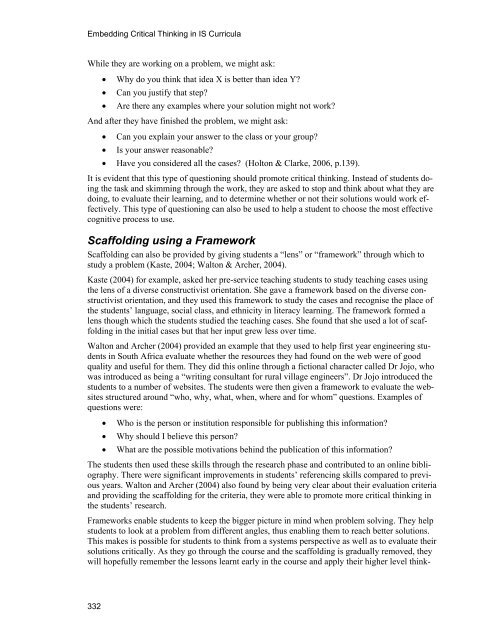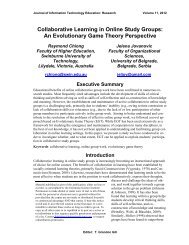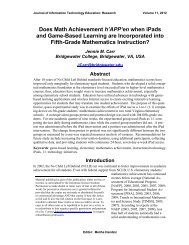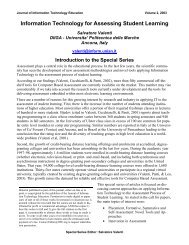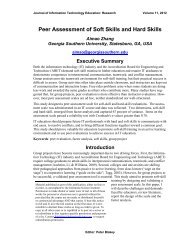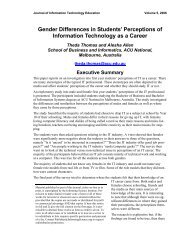Put Title Here Using Heading 1 Style - Journal of Information ...
Put Title Here Using Heading 1 Style - Journal of Information ...
Put Title Here Using Heading 1 Style - Journal of Information ...
Create successful ePaper yourself
Turn your PDF publications into a flip-book with our unique Google optimized e-Paper software.
Embedding Critical Thinking in IS Curricula<br />
While they are working on a problem, we might ask:<br />
332<br />
• Why do you think that idea X is better than idea Y?<br />
• Can you justify that step?<br />
• Are there any examples where your solution might not work?<br />
And after they have finished the problem, we might ask:<br />
• Can you explain your answer to the class or your group?<br />
• Is your answer reasonable?<br />
• Have you considered all the cases? (Holton & Clarke, 2006, p.139).<br />
It is evident that this type <strong>of</strong> questioning should promote critical thinking. Instead <strong>of</strong> students doing<br />
the task and skimming through the work, they are asked to stop and think about what they are<br />
doing, to evaluate their learning, and to determine whether or not their solutions would work effectively.<br />
This type <strong>of</strong> questioning can also be used to help a student to choose the most effective<br />
cognitive process to use.<br />
Scaffolding using a Framework<br />
Scaffolding can also be provided by giving students a “lens” or “framework” through which to<br />
study a problem (Kaste, 2004; Walton & Archer, 2004).<br />
Kaste (2004) for example, asked her pre-service teaching students to study teaching cases using<br />
the lens <strong>of</strong> a diverse constructivist orientation. She gave a framework based on the diverse constructivist<br />
orientation, and they used this framework to study the cases and recognise the place <strong>of</strong><br />
the students’ language, social class, and ethnicity in literacy learning. The framework formed a<br />
lens though which the students studied the teaching cases. She found that she used a lot <strong>of</strong> scaffolding<br />
in the initial cases but that her input grew less over time.<br />
Walton and Archer (2004) provided an example that they used to help first year engineering students<br />
in South Africa evaluate whether the resources they had found on the web were <strong>of</strong> good<br />
quality and useful for them. They did this online through a fictional character called Dr Jojo, who<br />
was introduced as being a “writing consultant for rural village engineers”. Dr Jojo introduced the<br />
students to a number <strong>of</strong> websites. The students were then given a framework to evaluate the websites<br />
structured around “who, why, what, when, where and for whom” questions. Examples <strong>of</strong><br />
questions were:<br />
• Who is the person or institution responsible for publishing this information?<br />
• Why should I believe this person?<br />
• What are the possible motivations behind the publication <strong>of</strong> this information?<br />
The students then used these skills through the research phase and contributed to an online bibliography.<br />
There were significant improvements in students’ referencing skills compared to previous<br />
years. Walton and Archer (2004) also found by being very clear about their evaluation criteria<br />
and providing the scaffolding for the criteria, they were able to promote more critical thinking in<br />
the students’ research.<br />
Frameworks enable students to keep the bigger picture in mind when problem solving. They help<br />
students to look at a problem from different angles, thus enabling them to reach better solutions.<br />
This makes is possible for students to think from a systems perspective as well as to evaluate their<br />
solutions critically. As they go through the course and the scaffolding is gradually removed, they<br />
will hopefully remember the lessons learnt early in the course and apply their higher level think-


